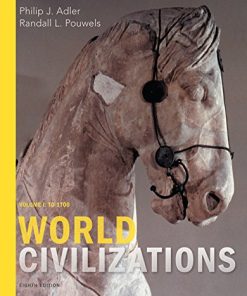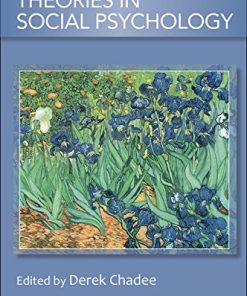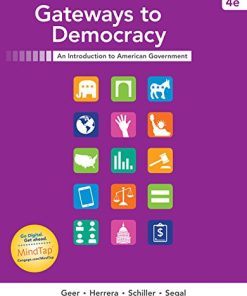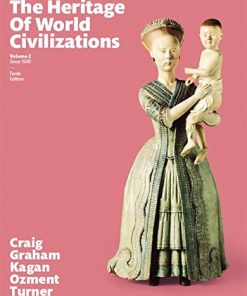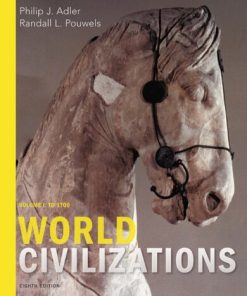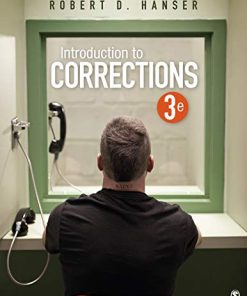World Civilizations: Volume I: To 1700 8th Edition E-book PDF Version – Ebook PDF Version
$50.00 Original price was: $50.00.$25.00Current price is: $25.00.
World Civilizations: Volume I: To 1700 8th Edition E-book PDF Version – Ebook PDF Version – Digital Instant Dowload.
World Civilizations: Volume I: To 1700 8th Edition E-book PDF Version – Ebook PDF Version – Digital Instant Dowload.
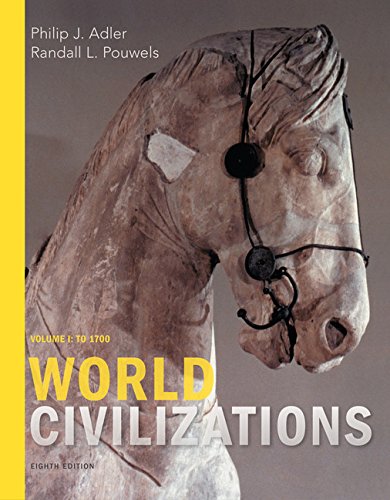
Product details:
- ISBN-10 : 9781305959903
- ISBN-13 : 978-1305959903
- Author: Philip J. Adler (Author), Randall L. Pouwels (Author)
Short chapters, great stories, and study tools! Adler and Pouwels’s WORLD CIVILIZATIONS is a vibrant introduction to world history structured to meet the demands of your study schedule. It’s clearly written, packed with charts and illustrations, and loaded with review features so you’ll be up to date in class and ready for tests. And, because WORLD CIVILIZATIONS offers extensive coverage of Asia, Africa, and the Middle East, you’ll have timely historical insights into the issues that make today’s news. Get this book and discover how manageable and interesting history can be.
Table of contents:
Unit I: FROM HUMAN ORIGINS TO AGRARIAN COMMUNITIES, c. 100,000–¬500 B.C.E.
1. The Earliest Human Societies.
2. Mesopotamia.
3. Early Africa and Egypt.
4. Central Asia and India’s Beginnings.
5. Ancient China to 221 B.C.E.
6. Settlement of the Americas and the Pacific Island.
Worldview I: From Human Origins to Agrarian Communities, 100,000–500 B.C.E.
Unit II: CLASSICAL CIVILIZATIONS OF THE WORLD, 500 B.C.E.–800 C.E.
7. New Civilizations and Empires in Western and Central Asia.
8. The Greek Adventure.
9. Greek Humanism, 800–100 B.C.E.
10. Rome: From City-State to Empire.
11. The Roman Empire and the Rise of Christianity in the West, 31 B.C.E.–800 C.E.
12. Iran, India, and “Global” Trade.
13. Imperial China in Its Golden Age.
Worldview II: Classical Civilizations of the World, 500 B.C.E.–800 C.E.
Unit III: THE POST-CLASSICAL ERA, c. 650–1500 C.E.
14. The Americas to the Fifteenth Century.
15. Islam.
16. Mature Islamic Civilization and the First Global Civilization.
17. Africa from Axum to 1400.
18. The Mongols Unify Eurasia.
19. Japan and Southeast Asia.
20. The European Middle Ages, c. 800–1500.
21. The Late European Middle Ages and the Renaissance.
Worldview III: The Post-Classical Era, 800–1400 C.E.
Unit IV: EXPANDING WEBS OF INTERACTION, c. 1400–1800.
22. A Larger World Opens.
23. Religious Division and Political Consolidation in Europe.
24. The Gunpowder Empires of Western and Southern Asia.
25. Africa in the Era of Expansion.
26. China from the Ming Through the Early Qing Dynasty.
27. Japan and Southeast Asia in the Era of European Expansion.
28. From Conquest to Colonies in Hispanic America.
Worldview IV: Expanding Webs of Interaction, 1400–1700 C.E.
Unit V: REVOLUTIONS, IDEOLOGY, THE NEW IMPERIALISM, AND THE AGE OF EMPIRE, 1700–1920.
29. The Scientific Revolution and Its Enlightened Aftermath.
30. Liberalism and the Challenge to Absolute Monarchy.
31. The Early Industrial Revolution.
32. Europe: New Ideas and New Nations.
33. Advanced Industrial Society.
34. The Islamic World, 1600–1917.
35. India and Southeast Asia Under Colonial Rule.
36. European Imperialism and Africa During the Age of Industry.
37. China in the Age of Imperialism.
38. Latin America from Independence to Dependent States.
39. Modern Science and Its Implications.
Worldview V: Revolutions and the Age of Empire, 1600–1914.
Unit VI: TOWARD A GLOBALIZED WORLD, 1916–Present.
40. World War I and Its Disputed Settlement.
41. A Fragile Balance: Europe in the Twenties.
42. The Soviet Experiment to World War II.
43. Totalitarianism Refined: The Nazi State.
44. East Asia in a Century of Change.
45. World War II.
46. The Cold World War.
47. Decolonization of the Non-Western World.
48. The New Asia.
49. Africa’s Decolonization and Independence.
50. Latin America in the Twentieth Century.
51. The Reemergence of the Muslim World.
52. Collapse and Reemergence in Communist Europe.
53. A New Millennium.
Glossary.
Index.
You may also like…
History - American Studies




